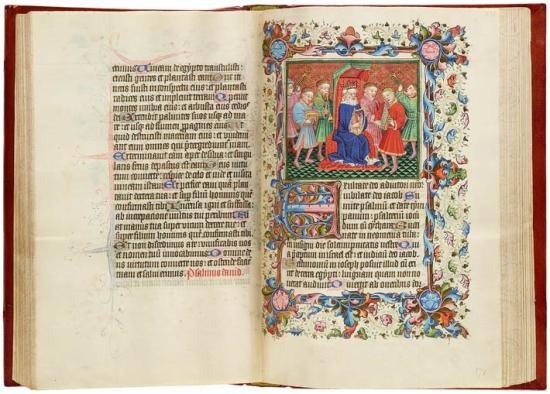Musicians Have Always Been Snappy Dressers

Warwick Psalter-Hours, in Latin
Purchased on the Belle da Costa Greene Fund, with the assistance of the Fellows, and the special assistance of the Hon. Robert Woods Bliss, Mrs. W. Murray Crane, Mr. Childs Frick, Mr. William S. Glazier, Mrs. Matilda Geddings Gray, Mr. Arthur A. Houghton, Jr., Mr. and Mrs. Donald F. Hyde, Mr. Milton McGreevy, Colonel David McC. McKell, Mr. Joseph V. Reed, Mrs. Landon K. Thorne, Mr. Ralph Walker, Mr. Christian A. Zabriskie, and an anonymous foundation, 1958
Psalm 80 in medieval Psalters was traditionally illustrated with an image of David playing the harp. In this prayer book, a group of young men — all fashionably attired — joins the king in making music with a variety of instruments. They wear the knee-length, fur-lined gown, belted at the waist and with a full or slit skirt. Pleats at the skirt, bodice, and upper sleeves make the garment quite ample. The man's gown evolves quickly: the skirt gets shorter and the shoulders get wider. The musicians sport the bowl haircut called a "not heed."
Peacocks of the Midcentury
In 1435, during the final chapter of the Hundred Years' War, Duke Philip the Good switched sides and supported King Charles VII. By the following year, the English occupation of Paris ended. When Charles VII regained Normandy and Aquitaine in 1453, the long war was finally over. In the ensuing period of peace and prosperity, fashion revived.
These decades saw the last of the houpeland. It continued to be worn by men and women in provincial areas, but in France and Flanders it was appropriate only for formal occasions. Men more often wore the gown: full or knee length, belted at the waist. Over the course of these thirty years, men's gowns, via flaring pleats and ample shoulder padding, assumed a flattering, V-shaped silhouette. While the chaperon remained popular, new hats also arrived.
Women's gowns featured wide V necks with contrasting collars and partlets (plackards worn at the midriff). Headgear atop the temples continued to evolve, growing ever more extravagant. Burlets got thicker and climbed higher. Butterfly veils, supported by wires, floated like sails above ladies' heads.